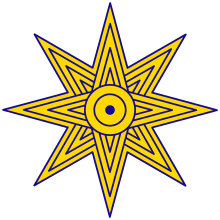Star of Ishtar

The Star of Ishtar or Star of Inanna is a symbol of the ancient Sumerian goddess Inanna and her East Semitic counterpart Ishtar. The owl was also one of Ishtar's primary symbols. Ishtar is mostly associated with the planet Venus, which is also known as the morning star.
History

The star of Inanna usually had eight points,[1] though the exact number of points sometimes varies.[2] Six-pointed stars also occur frequently, but their symbolic meaning is unknown.[3] It was Inanna's most common symbol[1] and, in later times, it became the most common symbol of the goddess Ishtar, Inanna's East Semitic counterpart.[1] It seems to have originally borne a general association with the heavens,[1] but, by the Old Babylonian Period, it had come to be specifically associated with the planet Venus, with which Ishtar was identified.[1] Starting during this same period, the star of Ishtar was normally enclosed within a circular disc.[3]
During later times, slaves who worked in Ishtar's temples were sometimes branded with the seal of the eight-pointed star.[3] On boundary stones and cylinder seals, the eight-pointed star is sometimes shown alongside the crescent moon, which was the symbol of Sin, god of the Moon, and the rayed solar disk, which was a symbol of Shamash, the god of the Sun.[4][2]
The rosette was another important symbol of Ishtar which had originally belonged to Inanna.[5] During the Neo-Assyrian Period, the rosette may have actually eclipsed the eight-pointed star and become Ishtar's primary symbol.[6] The temple of Ishtar in the city of Aššur was adorned with numerous rosettes.[5]

Flag of Iraq
In Arabic, the symbol is known as (Arabic: نجمة عشتار, romanized: najmat eshtar). The stars of Ishtar and Shamash featured on the coat of arms of the Kingdom of Iraq from 1932-1959.
A simplified version with red rays and a yellow centre was incorporated into the flag of Iraq from 1959–1963. It also featured in a combination with the sun of Shamash on the national emblem of Iraq from 1959-1965.[7][8][9]
References
- ^ a b c d e Black & Green 1992, pp. 169–170.
- ^ a b Liungman 2004, p. 228.
- ^ a b c Black & Green 1992, p. 170.
- ^ Gressman & Obermann 1928, p. 81.
- ^ a b Black & Green 1992, p. 156.
- ^ Black & Green 1992, pp. 156–157.
- ^ http://www.pjsymes.com.au/articles/CBI-First.htm
- ^ Dawisha, Adeed (January 2003). "Requiem for Arab Nationalism". Middle East Quarterly.
- ^ Amatzia Baram, "Mesopotamian Identity in Ba'thi Iraq," Middle Eastern Studies, Oct. 1983, p. 427.
Bibliography
- Black, Jeremy; Green, Anthony (1992), Gods, Demons and Symbols of Ancient Mesopotamia: An Illustrated Dictionary, The British Museum Press, ISBN 0-7141-1705-6
- Collins, Paul (1994), "The Sumerian Goddess Inanna (3400-2200 BC)", Papers of from the Institute of Archaeology, vol. 5, UCL
- Gressmann, Hugo; Obermann, Julian (1928), The Tower of Babel, Jewish Institute of Religion Press, p. 81
- Liungman, Carl G. (2004), Symbols: Encyclopedia of Western Signs and Ideograms, Lidingö, Sweden: HME Publishing, ISBN 978-9197270502
See also
External links
![]() Media related to Star of Ishtar at Wikimedia Commons
Media related to Star of Ishtar at Wikimedia Commons


